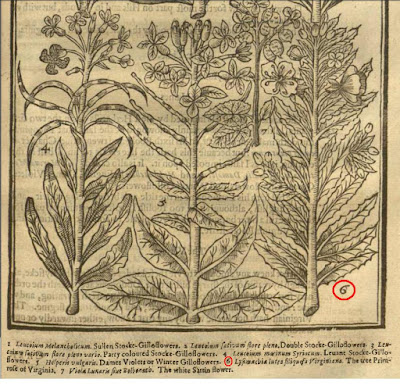Lysimachia lutea siliquosa Virginiana. The
tree Primrose of Virginia. Oenothera biennis L.
 |
| BHL/MOBOT |
ジョン・パーキンソン (John
Parkinson 1567–1650) は英国中世の庭師・植物学者で,薬剤師見習いからスタートし,1617年薬種商組合 (The
Society of Apothecaris) の創設に参加,20年には理事になるが庭仕事に熱中するようになり,22年には引退した.
彼を有名にした『太陽の園,地上の楽園 ”Paradisi in Sole Paradisus Terrestris”』(1629)(左図)のタイトルは,自分の名前(park-in-son)をラテン語にしたもので,第一部「花園」(The Garden of pleasant Flowers.),第二部「菜園」(The Kitchen Garden.),第三部「果樹園」(The Orchard)よりなる園芸書.庭園設計や土づくり,種まき,育て方などの具体的な庭造りのノウハウと,約800種の植物の図が掲載されている.諸外国から移入された,或は英国自生の庭園用の美しい植物が多く取り上げられ,それまでの中世の菜園の実用主義や医術・治療を目的とした本草書とは,大きく異なる内容となっている.
彼を有名にした『太陽の園,地上の楽園 ”Paradisi in Sole Paradisus Terrestris”』(1629)(左図)のタイトルは,自分の名前(park-in-son)をラテン語にしたもので,第一部「花園」(The Garden of pleasant Flowers.),第二部「菜園」(The Kitchen Garden.),第三部「果樹園」(The Orchard)よりなる園芸書.庭園設計や土づくり,種まき,育て方などの具体的な庭造りのノウハウと,約800種の植物の図が掲載されている.諸外国から移入された,或は英国自生の庭園用の美しい植物が多く取り上げられ,それまでの中世の菜園の実用主義や医術・治療を目的とした本草書とは,大きく異なる内容となっている.
 |
| BHL/MOBOT & Biblioteca Digital del Real Jardín Botánico |
この書には108 の全ページ大の,囲みの中に多くの植物を描き込んだ木版画に800種もの植物の絵が載せてある.その何点かはドイツ人画家クリストファー・スウィッツァー(Christopher
Switzer)による新しいオリジナルの図だが,多くの図版は,マティアス・デ・ロベル(Mathias de l’Obel),カロルス・クルシウス(Carolus Clusius),オランダの彫版職人クリスピン・ファン・ドゥ・パス(Crispijn van de Passe)の『花の園』(Hortus Floridus)の図版をコピーしたもので(右に一例を示す),しかも粗雑な彫り方で,添付されているすばらしい説明文にそぐわない.
この著作は当時の国王,チャールズ一世(Charles I, 1600 – 1649, 在位:1625 - 1649)の皇后で,園芸の愛好者 ヘンリエッタ・マリア・オブ・フランス (Henrietta Maria of France, 1609 –1669) に献呈され,その後彼はチャールズ一世のお抱え植物学者となった.
(左図,Henrietta Maria, with her court dwarf, Jeffrey Hudson,(1633), ヴァン・ダイク,ナショナル・ギャラリー(ワシントン)所蔵)
背後のオレンジの木の鉢植えはヘンリエッタ・マリアが庭園を好んでいたことを表していると考えられている.(from Wiki-commons)
この書は主に庭園を彩る観賞価値の高い植物を収載しているため,薬草として名高い Lysimachia lutea(Yellow Loose-strife)の記事はない.しかし,当時北米大陸から導入されたメマツヨウグサが
Lysimachia の仲間として,ストック(Viola Matronalis. Dames Violets)の章に,”Lysimachia lutea siliquosa Virginiana. The tree Primrose of
Virginia.” の名で紹介されている.この植物をどの類の章に入れるか,パーキンソンは大分迷ったようではあるが,花が四辧で香りがよいことから,ストックの項に入れたのであろう.なお本文中の,“Gilloflowers”とはカーネーションの古名で,香りがこの花に似ているので,ストック類が
“Queenes Gilloflowers” と呼ばれた.
この北アメリカより移入された”Lysimachia lutea siliquosa Virginiana" は Marcus Woodward によってメマツヨイグサ(Oenothera biennis L.)と考定されている.
“PARADISI IN SOLE PARADISUS TERRESTRIS” BY
JOHN PARKINSON
“The Garden of pleasant Flowers.”
CHAP. XLI.
1 . Hesperis, sive Viola Matronalis. Dames Violets, or Queenes
Gilloflowers.
 |
| BHL/MOBOT |
2. Hesperis Pannonica. Dames Violets of Hungary
The leaves of this
Violet are very like the former, but smoother and thicker, and not at all
indented, or cut in on the edges : the flowers are like the former, but of a sullen
pale colour, turning themselves, and seldome lying plaine open, having many purple
veines, and streakes running through the leaves of the flowers, of little or no
sent in the day time, but of a very sweete lent in the evening and morning ;
the seedes are alike also, but a little browner.
3. Lysimachia lutea siliquosa Virginiana.
The tree Primrose of Virginia.
Unto what tribe or kindred I might referre
this plant, I have stood long in suspence, in regard I make no mention of any
other Lysimachia in this work : lest therefore it should lose all place, let me
ranke it here next unto the Dames Violets, although I confesse it hath little
affinity with them. The first yeare of the sowing the seede it abideth without
any stalke or flowers lying upon the ground, with divers long and narrow pale
greene leaves, spread oftentimes round almost like a Rose, the largest leaves
being outermost, and very small in the middle : about May the next yeare the
stalke riseth, which will be in Summer of the height of a man, and of a strong
bigge size almost to a mans thumbe, round from the bottome to the middle, where
it groweth crested up to the toppe, into as many parts as there are branches of
flowers, every one having a small leafe at the foote thereof : the flowers
stand in order one above another, round about the tops of the stalks, every one
upon a short foot-stalke, consisting of foure pale yellow leaves, smelling
somewhat like unto a Primrose, as the colour is also (which hath caused the
name) and standing in a greene huske, which parteth it selfe at the toppe into
foure parts or leaves, and turne themselves downewards, lying close to the
stalke : the flower hath some chives in the middle, which being past, there
come in their places long and cornered pods, sharpe pointed at the upper end,
and round belowe, opening at the toppe when it is ripe into five parts, wherein
is contained small brownish seed : the roote is somewhat great at the head, and
wooddy, and branched forth diversly, which perisheth after it hath borne seede.
他のリシマキアにはこの書では言及しないので,この植物をどの種類に入れるのか,長いこと迷ったが,何処にも入れないことも出来ないので,あんまり類似性はないと認めながら,” Dames Violets (ストック)” の次にランク付けた.播種の一年後は,地上には莖も花も現さず,多くの長く細い薄緑色の葉を,多くの場合まるでバラのように丸く広げる(ロゼッタ).外側の葉が最も大きく,内の葉は非常に小さい.次の年の五月ごろに莖が伸び出し,夏には人の背丈まで成長する.その莖は,硬くて人の親指の太さほどもあり,根際から中ほどまでは丸く,梢頂まで毛がついている.多くの場所に花莖があり,その全てには付け根に小さな葉が着いている.花は他の花の上に順番につき(無限花序?),莖頂に向かって環状につく.全ての花は短い莖の足(子房)の上に咲くが,四辧の薄黄色の花弁からなる,一寸サクラソウ (Primrose, Cowslip?) に似た香りがする.そのため,色も似ているのでこのように呼ばれている.この花は緑色の殻(子房)の上につくが,この殻はその先で四つの部分或は葉(萼)に別れ,莖に密着して垂れ下がる.花の中心部にはsome chivesがあり,後にその場所には,先端が尖り,基部では丸い,長い角ばった莢がつく.熟すると先端部は五つに分かれ,その中には小さな茶色の種が入っている.根はやや先端が太くなり,木質で,数多く分岐し,種を結んだ後は枯れる.
The Place.
The two first grow for
the most part on Hils and in Woods, but with us in Gardens onely.
The last, as may be well understood by the
title, came out of Virginia
最後の種は,名稱でわかるように,バージニアから移入された.
The Time.
They flower in May, June, and July.
(三種とも)五月,六月,七月に花をつける.
The Names.
The name of Hesperis is
imposed by most Herbarists vpon the two first plants, although it is not
certainly knowne to be the same that Theophrastus doth make mention of, in his sixth
Booke and twenty five Chapter de caujis plantarum : but because this hath the
like effects to smell best in the evening, it is (as I said) imposed upon it.
It is also called Viola Marina Matronalis, Hyemalis, Damascena and Muschatella
: In English, Dames Violets, Queens Gilloflowers, and Winter Gilloflowers.
The last hath his Latine name in the title
as is best agreeing with it, and for the English, although it be too foolish I
confesse, yet it may passe for this time till a fitter be given, unlesse you
please to follow the Latine, and call it Virginia Loose-strife.
最後の種は,そのラテン名がその形態を良く表している(siliquosa とは, codded の意味).英語名は,正直に言うと非常に馬鹿らしいとは思うが,もっとよい名前が付くまでは,この名が通用しよう.でなければ,ラテン名に従うか,Virginia Loose-strife (バージニア産のセイヨウクサレダマ)と呼ぶべきであろう.
The Vertues.
I never knew any
among vs to use these kindes of Violets in Physicke, although by reason of the sharpe
biting taste, Dodonaeus accounteth the ordinary sort to be a kinde of Rocket,
and saith it provoketh sweating, and urine : and others affirme it to cut, digest,
and cleanse tough flegme.
The Virginian hath not beene used by any
that I know, either inwardly or outwardly.
バージニア種は,私が知っている限りにおいては,内服用・外用何れにも使われたことはない.出来るだけ原文に忠実にテキスト化したので,スペルは現在の英語とは異なる点もある.また, "u", "v", "s", "j" は現代英語の用法に従って変更した.
誤読解等の疑問がある場合は Biodiversity Heritage Library (BHL) に公開されている原典を参照されたい.


0 件のコメント:
コメントを投稿